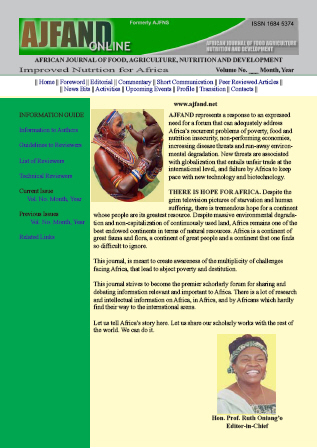
|
African Journal of Food, Agriculture, Nutrition and Development
Rural Outreach Program
ISSN: 1684-5358
EISSN: 1684-5358
Vol. 13, No. 1, 2013, pp. 7273-7287
|
 Bioline Code: nd13013
Bioline Code: nd13013
Full paper language: English
Document type: Research Article
Document available free of charge
|
|
|
African Journal of Food, Agriculture, Nutrition and Development, Vol. 13, No. 1, 2013, pp. 7273-7287
| en |
ANTIOXIDATIVE AND RADICAL SCAVENGING ACTIVITIES OF PROPOLIS EXTRACTS IN FOOD MODELS
Ukulo, J.W.; Kiiyukia, C. & Kenji, G.M.
Abstract
Propolis samples collected from Mwingi, Malindi, Uasin-gishu and Meru south
districts in Kenya were extracted using ethanol and methanol. The methanol extracts
were further partitioned into ethyl acetate, hexane and aqueous fractions. The extracts
were concentrated and dried in vacuum evaporator. Their antioxidative activities were
tested in linoleic acid-β-carotene system and in soybean oil. The extracts’ radical
scavenging activities against 2,2–diphenyl-1-picrylhydrazil (DPPH) were also
studied. Significant differences were observed between the samples as well as within
the samples’ various extracts. The ethanol extract of propolis (EEP) and the ethyl
acetate fractions from all four samples had higher 2,2–diphenyl-1-picrylhydrazil
(DPPH) radical scavenging activity compared to the aqueous and the hexane extracts
at a concentration of 500 μg/ml. Malindi EEP at a concentration of 500 μg/ml had a
significantly (p < 0.05) higher radical scavenging activity (87.7%) than all the other
EEP’s. The least radical scavenging activity was observed in Uasin-gishu EEP with
73.3%. The Mwingi ethyl acetate extract at a concentration of 500 μg/ml had 79.2%
radical scavenging activity which was the highest observed amongst the ethyl acetate
fractions and the least was in Uasin-gishu sample having 66.1% activity. The highest
activity among the aqueous extracts was 7.1% in Meru South sample at a
concentration of 500 μg/ml. Radical scavenging activity did not differ in all four
aqueous fractions. There was no significant difference (p < 0.05) observed in the
antioxidation activity of Mwingi, Meru south and Malindi EEPP’s, in the linoleic
acid-β-carotene system at a concentration of 500 μg/ml. The EEP’s were the most
active against oxidation of the system with a range of 61.7% in Uasin-gishu sample to
71.8% in Malindi sample while the aqueous was the least active with a range of 5.8%
to 11.7% in Uasin-gishu and Malindi samples respectively. The EEP’s at a
concentration of 1mg/ml showed greater activity against antioxidation of soybean oil
compared to butylated hydroxyltoluene (BHT) at a concentration of 0.2 μg/ml for the
first 25 days of the test. After the 25th day, there was sharp increase in peroxide values
in all the EEPs showing loss of antioxidation strength.
Keywords
Propolis, Radical scavenging, antioxidation activity
|
| |
© Copyright 2013 - African Journal of Food, Agriculture, Nutrition and Development
Alternative site location: http://www.ajfand.net/
|
|
